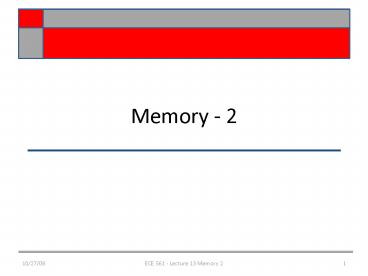Memory - 2 - PowerPoint PPT Presentation
1 / 20
Title:
Memory - 2
Description:
... Lecture 13 Memory 2 * DDR SDRAM Double data rate SDRAM Double the data transfer rate of an SDRAM by transferring on both edges of the clock Access and setup ... – PowerPoint PPT presentation
Number of Views:57
Avg rating:3.0/5.0
Title: Memory - 2
1
Memory - 2
2
Memory
- The internal structure of the ICs
- ROM Types and RAM
3
Memory Types
- How a ROM works
4
A 128 x 1 ROM
- The basic structure
5
Larger Array Sizes
- Arranged in blocks
6
Commercial ROM Types
- Table 9-5
- Type Tech ReadCyc WrCyc Comments
- MASK ROM NMOS 10-100ns 4 weeks Write
once, low pwr - CMOS
- MASK ROM Bipolar lt100ns 4 weeks
Write once, h pwr -
low density - PROM Bipolar lt100ns
10-50us/byte Write once, h pwr - EPROM NMOS 25-200ns 10-50us/byte
Reusable, low pwr - CMOS
- EEPROM NMOS 50-200ns 10-50us/byte
10,000 to 100,000 -
writes per location
7
EPROM
- Erasable Programable Read Only Memory
8
EPROM
- Uses a floating gate for the FET at each bit
location - User uses a programming voltage that causes a
temporary breakdown in the dielectric between the
gate and the floating gate to charge it. - When programming voltage is removed the charge
stays - How long? EPROM manufacturers guarantee
properly programmed bit has 70 of charge after
10 years. - Use UV light to erase
9
EEPROM
- Electrically Erasable PROM
- Like the EPROM only electrically erasable in
circuit. - Many times referred to a flash programmable
memory - Very slow on writes so not a substitute for RAM
10
General Block Diagram
- xROM
11
General Timing
- General timing parameters
12
The timing parameters
- Access time from address tAA
- Access time from chip select - tACS
- Output-enable time - tOE
- Output-disable time - tOZ
- Output-hold time - tOH
13
R/W Memory
- Memory to store and retrieve data when more than
F/Fs - A few types
- Static RAM SRAM
- As long as power is maintained data is held
14
SRAM
- The data storage
15
A static RAM chip
- Internal an arrangement of storage sturctures
16
SRAM Timing
- Timing for write similar (see Fig 9-23)
17
DRAM
- Next step in memory is Synchronous SRAM which has
a clocked interface for control, address and
data. - Then comes DRAM dynamic ram
- In DRAM data is stored
- in a semiconductor
- capicator.
18
DRAM Read
- A read sees the bit line precharged to high.
- The word line is then activated
- If cell stores a 0 then there is a small drop on
the voltage on the bit line - This is monitored by a sense amp which provides
the value stored - Value must be written back after the read.
19
DRAM Refresh
- Charge stored leaks off over time
- Must restore the values stored
- A 4096 row DRAM refresh every 64ms
- Thus each row every 15.6 usec
- Larger DRAMs are banks of smaller
20
DDR SDRAM
- Double data rate SDRAM
- Double the data transfer rate of an SDRAM by
transferring on both edges of the clock - Access and setup times are the same as SRAM
- Increased data thruput as data is transferred in
blocks.































